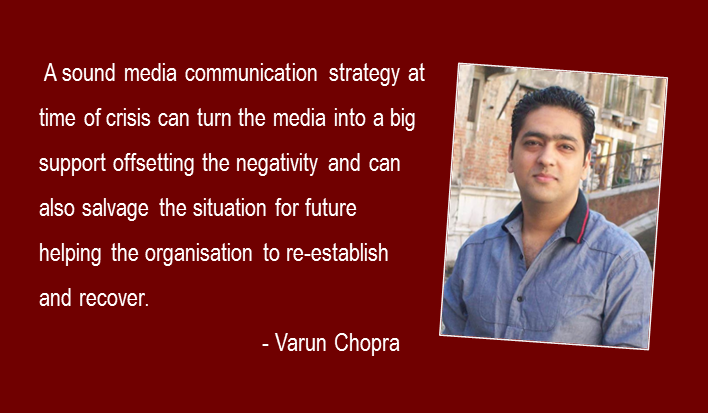It is critical that organisations today realise that crisis management has two very strong aspects, operations and communication. Every organisation should have a Crisis response plan to mitigate the negative effects of the crisis by careful assessment of probable origin, causes and effects. A team of senior executives including the Communication / PR Lead of the organisation, Legal Head, Quality Management Head, Business Heads and Subject knowledge experts for specific crisis should be identified to serve as an organisation’s crisis response team. It is important to communicate effectively with the employees, the customers as well as with media efficiently during critical time. Whether reactive or proactive, Information / Statements given out during crisis should be specific, sensible and pertinent.
In today’s tech-intensive world, the turnaround time for crisis mitigation is minimalist and the communication has to be immediate and in some cases anticipatory. A small rumour can give rise to big crisis and the team has to be ready. An Ostrich approach with the head buried in the sand waiting for the crisis to pass is an absolute passé.
As a pre-crisis exercise it is essential to establish a system, which would connect you with your stake holders promptly using various channels. It is a common practice nowadays to create anticipatory holding statement about vulnerable areas like products, accidents, quality issues within the organisation. Though the specifics depending on the crisis are added later, this exercise in advance keeps an organisation crisis ready by developing the precise messages required for any situation. A spokesperson needs to be designated and trained to deal with the media and other stakeholders. This would also give a single point contact to everyone within the organisation and outside to direct the media and queries to. Training of the spokesperson’s for different stakeholders is imperative beforehand to project confidence and reliability. The training should include communication on-camera, at press conferences, at employee meetings, one on one interviews etc.
The first step to Crisis communication is to gather information on the crisis promptly to ascertain the nature, reason and the origin of Crisis. Quick analysis and brain storming of the same with the team would validate facts, figures and the way ahead, which in turn would go into the holding statements.
The messaging has to be simple, precise stating honest facts, admitting mistakes if any and stating the steps being taking to alleviate the effects. Ideally the holding statement should not exceed 150 words and should be adapted to be group specific as different stakeholders need diverse assurances. For shareholders the financial effect is important and the employees at the time of crisis need to be reassured about their pay and position. Statement would also need to adapt to different forms of media as well. With so many Social media platforms available today, each has a different messaging style, some visual others verbose and varied psychological user profile. The communication needs to be adapted likewise, promptly. Setting up multiple channels of communication is vital. Emails, text, whatsapp groups, facebook page if needed, can be great to disseminate information and updates and also serves as interactive two way channels.
Internally too, especially in multi-location organisations, real-time communication using crisis communication apps can ensure latest information is available at any location. People armed with the right information, especially at the time of crisis, rationalise response and are the best defence to minimise loss in production and profits.
Effective communication with media is very essential and the switch from proactive approach, where one promotes the organisation to a reactive approach, where one is working towards protecting the organisation has to be clear. At the time of crisis the largeness of the organisation and the good work in past is of no consequence to the reporters. Their focus will be on the situation and the spokespersons communication should focus on that. A sound media communication strategy at time of crisis can turn the media into a big support offsetting the negativity and can also salvage the situation for future helping the organisation to re-establish and recover.



Very well put together piece on crisis. Points articulated with absolute clarity. Great insight particularly the role of social media in crisis communication
Very well written article with clear guidance on the way to manage crisis and preserve brand reputation . Congrats Varun .
Its a wonderfully written article with strong arguments.
Nice piece good to read some basics !!
Nothing prepares an organization for managing communication during crises as a baptism with the searing fire of experience. This is where the expertise of able, non-meandering, strsight-talking consultants holds immeasurable value. Well done Varun, I am confident that you are well on the road to becoming a spurred member of this exclusive clique.